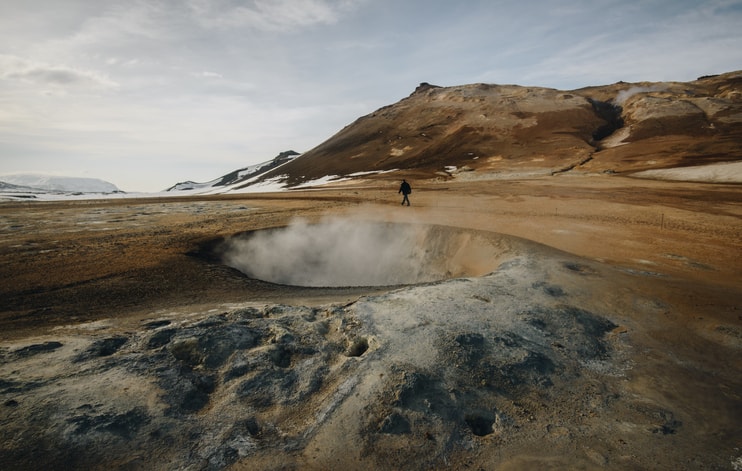Wednesday, February 21, 2024
Spain has the right subsoil to harness the Earth's heat as a way to produce electricity, but technical complexity and high costs have slowed its expansion
Source: Colpisa
It is probably the least known and least developed renewable energy. But it will be increasingly present in the energy plans of half the world. Geothermal energy is powered by the high temperatures inside the Earth, which range from 15°C at the surface to 4,000°C at the core.
According to data from the International Energy Agency, electricity generation from geothermal sources increased by 2% over the last year, although that is down from the pace seen in the previous five years. Turkey, Indonesia, and Kenya account for most of this growth and are expected to continue to do so because they have abundant and untapped resource availability.
Their 'clean' character has attracted the interest of fortunes such as Bill Gates, who invests in research and development of this energy alternative through his Breakthrough Energy Ventures (BEV) fund. Now in Spain, the Canary Islands will be the leading player in the first deep drilling to explore the potential of this energy source, which is called the energy of the future. The five core concepts below are necessary to understand it.
- How is it extracted?
Geothermal energy is a source of energy that is stored beneath the Earth's surface in the form of heat. That is why it is strongly associated with volcanoes, hot springs, fumaroles, and geysers and is easier to find in areas where these phenomena occur.
To use geothermal energy, hot water is pumped deep through the ground in a high-pressure well. When the water reaches the surface, the pressure decreases, causing the water to turn into steam, which spins a turbine connected to a generator that produces electricity.
Then the steam is cooled in a cooling tower and condenses back into water. The cooled water is pumped back to Earth to start the process again.
- Is it difficult to store and manage it?
In the 21st century, attempts were made to take advantage of what are known as deep geothermal reservoirs since they can be used for electricity production after activating the reservoir. However, searching for and investigating these reservoirs is somewhat costly in economic terms since very sophisticated technologies are required.
In addition, one of the difficulties is transporting this energy that reaches us from inside the earth. So the use of this energy has been largely limited to areas where geothermal energy can be transported (water in the liquid phase or steam) to transfer heat from deep hot areas to near the surface, creating geothermal resources.
- How can it be used?
The direct use of heat is one of the oldest, most versatile, and common forms of geothermal energy utilization. Applications in bathrooms, space, and district heating, agriculture, aquaculture, and some industrial uses are the best known forms of utilization.
The most frequent applications of this type of energy are therefore the production of electricity, when dealing with high temperature reservoirs (above 100-150°C), or thermal uses in the industrial, service, and residential sectors, for temperatures below 100°C, either directly or through geothermal heat pumps (heating and cooling) for very low temperatures (below 25°C).
- Is it in Spanish homes now?
Very low temperature geothermal heat pump systems, which are very common in other European countries, are beginning to be developed in Spain and are expected to boom in the coming years.
The main advantage of these systems is that the geological conditions for their use are not very demanding, since this type of subsoil energy resource can be harnessed practically throughout Spain. It is an efficient technology for heating and cooling with significant energy savings.
Geothermal energy began to be researched in Spain after the 1973 energy crisis. The responsibility for assessing whether an area of the Spanish subsoil has geothermal potential lies with the Spanish Geological and Mining Institute (IGME), which in 1976 compiled the first general inventory of geothermal manifestations in the national territory.
With these reports in hand, it can be concluded that Spain has a geological structure conducive to the presence of geothermal resources in the subsoil, as evidenced by the presence of water, frequent seismic activity—albeit of low intensity—and the presence of volcanoes.
Although geothermal energy was widely studied during the 70s and 80s, especially for its use in heating, the projects did not go ahead for a variety of reasons, mainly economic, and the development of the geothermal area came to a standstill.
Nevertheless, in recent years, the IDAE has been promoting and supporting the installation of geothermal energy in different areas with subsidies and grants.
According to this organization, Spain is home to the largest site in southern Europe heated with this energy: the Sant Pau Art Nouveau Site. Other major current projects include the construction of the Madrid Norte district, where it is planned that the homes will be outfitted with this energy for their air-conditioning systems and which has been awarded a significant subsidy from European funds.
- Why is this energy source important?
Among other reasons, geothermal power is a renewable energy source that can contribute to reducing carbon emissions and weaning us off our dependence on fossil fuels.
However, geothermal technology is not yet on track to achieve the 13% net generation increases that would be needed each year by 2030. According to the International Energy Agency, to achieve those increases, policies to reduce costs and address challenges associated with pre-development risks are needed to scale up the rollout of geothermal resources for power generation.
¿Te ha parecido interesante?





